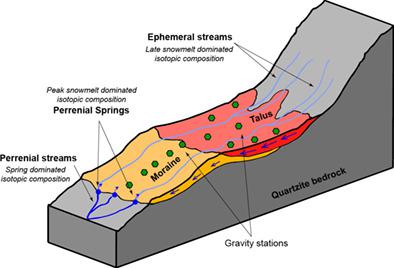当前位置:
X-MOL 学术
›
Hydrol. Process.
›
论文详情
Our official English website, www.x-mol.net, welcomes your
feedback! (Note: you will need to create a separate account there.)
Characterizing seasonal groundwater storage in alpine catchments using time‐lapse gravimetry, water stable isotopes and water balance methods
Hydrological Processes ( IF 2.8 ) Pub Date : 2020-08-16 , DOI: 10.1002/hyp.13884 Marie Arnoux 1 , Landon J. S. Halloran 1 , Eléonore Berdat 1 , Daniel Hunkeler 1
Hydrological Processes ( IF 2.8 ) Pub Date : 2020-08-16 , DOI: 10.1002/hyp.13884 Marie Arnoux 1 , Landon J. S. Halloran 1 , Eléonore Berdat 1 , Daniel Hunkeler 1
Affiliation

|
Alpine areas play a major role in water supply in downstream valleys by releasing water during warm and dry periods. However, the hydrogeology of alpine catchments, which are particularly exposed to the effects of climate change, is currently not well understood. Increasing our knowledge of alpine hydrogeological processes is thus of considerable importance for any forward‐looking hydrological investigations in alpine areas. The objectives of this study are to quantify seasonal groundwater storage variations in a small Swiss alpine catchment and to evaluate the capabilities of time‐lapse gravimetry in the identification of zones of high groundwater storage fluctuations. Time‐lapse gravimetric measurements enable rapid localisation of zones of dynamic groundwater storage changes and help to highlight aquifers with a higher storage decrease. Temperature sensors enable measurement of the temporal trend in stream and spring drying in the post‐snowmelt period. Stable isotope measurements allow us to identify the origin of surface water exiting the catchment. The results improve our comprehension of a conceptual schema highlighting two different hydrogeological systems: (a) a shallow, rapidly depleted one fed directly by snowmelt and (b) a deeper one, with a slower recession, fed by main recharge during peak snowmelt and emerging at the lower part of the catchment below the talus and moraine of the catchment where bedrock is exposed. These dynamics confirm the high variability of storage in the talus and moraine aquifers and highlight the dominant role of Quaternary deposits and their connectivity to store water over seasonal and multi‐year time‐scales. The mechanisms explaining the importance of Quaternary deposits are the combination of moraine and talus with different permeabilities allowing the storage of sufficient quantities of water permitting continuous release during drier periods of the year.
中文翻译:

使用延时重力法,水稳定同位素和水平衡方法表征高山流域的季节性地下水储量
高寒地区通过在温暖和干燥的时期释放水,在下游山谷的供水中发挥重要作用。但是,目前尚不清楚高山流域的水文地质,特别是受到气候变化影响的地区。因此,对于高山地区的任何前瞻性水文调查,增加我们对高山水文地质过程的了解都具有相当重要的意义。这项研究的目的是量化瑞士一个小高山流域的季节性地下水储量变化,并评估随时间重力法在确定高地下水储量波动区域中的能力。随时间推移的重量测量可以快速定位动态地下水储量变化的区域,并有助于以较高的储量减少来突出显示含水层。温度传感器可以测量融雪后溪流和春季干燥的时间趋势。稳定的同位素测量使我们能够确定流域外地表水的来源。结果提高了我们对突出两种不同水文地质系统的概念图式的理解:(a)由融雪直接补给的浅层,快速耗竭的系统;(b)由高峰融雪和新兴时期的主要补给补给的较深的,衰退较慢的系统在集水区距骨和冰ora以下的集水区下部,基岩裸露。这些动态证实了距骨和冰ora含水层中储存的高度可变性,并突出了第四纪沉积物的主要作用及其在季节性和多年时间尺度上与储存水的连通性。
更新日期:2020-10-06
中文翻译:

使用延时重力法,水稳定同位素和水平衡方法表征高山流域的季节性地下水储量
高寒地区通过在温暖和干燥的时期释放水,在下游山谷的供水中发挥重要作用。但是,目前尚不清楚高山流域的水文地质,特别是受到气候变化影响的地区。因此,对于高山地区的任何前瞻性水文调查,增加我们对高山水文地质过程的了解都具有相当重要的意义。这项研究的目的是量化瑞士一个小高山流域的季节性地下水储量变化,并评估随时间重力法在确定高地下水储量波动区域中的能力。随时间推移的重量测量可以快速定位动态地下水储量变化的区域,并有助于以较高的储量减少来突出显示含水层。温度传感器可以测量融雪后溪流和春季干燥的时间趋势。稳定的同位素测量使我们能够确定流域外地表水的来源。结果提高了我们对突出两种不同水文地质系统的概念图式的理解:(a)由融雪直接补给的浅层,快速耗竭的系统;(b)由高峰融雪和新兴时期的主要补给补给的较深的,衰退较慢的系统在集水区距骨和冰ora以下的集水区下部,基岩裸露。这些动态证实了距骨和冰ora含水层中储存的高度可变性,并突出了第四纪沉积物的主要作用及其在季节性和多年时间尺度上与储存水的连通性。











































 京公网安备 11010802027423号
京公网安备 11010802027423号